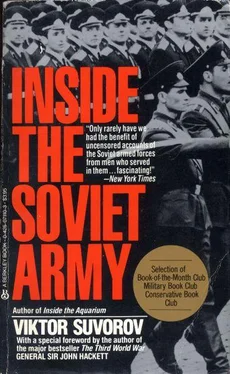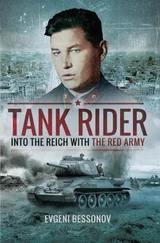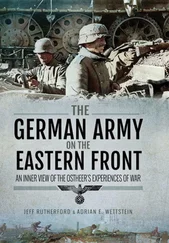Until May 1942, each Army fighting at the front had one penal battalion. These battalions were used in defence as well as during offensives. After this the situation altered — the battalions were only to be used, according to the new policy, in offensives. In defence they were to be employed only to counter-attack — and, after all, a counter-attack is itself an offensive action on a small scale. In addition to the battalions already serving with Armies, other battalions, subordinated to Fronts, were introduced. Each Front commander henceforth had between 10 and 15 penal battalions at his disposal.
Each battalion had an administrative group, a guard company and three penal companies. The permanent component of the battalion — the command staff and the guards — consisted of ordinary soldiers and officers who were selected for their obtuseness, their ferocity and their fanaticism. They were rewarded with unheard-of privileges. The officers received seven times the normal pay — for each year of service they were given seven years towards their pension.
The penal battalions contained individuals who had shown reluctance to fight and others who were suspected of cowardice. With them were officers and soldiers who had been sentenced for various crimes and offences. The officer's who were sent to the battalions lost any decorations they had been awarded, together with their ranks, and joined the battalion as privates.
During periods of calm the penal battalions were kept in the rear. At the last moment before an offensive, they were brought up, under guard, and positioned at the forward edge of the battle area. As the artillery preparation began, the guard company, armed with machine guns, would take their place behind the penal companies, who were then issued with weapons. Then, on the command `Advance to attack! the guard company's machine guns would force the reluctant penal companies to get to their feet and to advance. Being unable to move in any other direction, they attacked, frenziedly. The most brilliant victories achieved by the Soviet Army were bought with the blood of the penal battalions. They were given the hardest and most thankless tasks. They would break through the enemy's defences and then, sweeping through their midst, trampling on their corpses, would come the elite Guards divisions. Thereafter no one wanted the penal companies in the area. It was far better to let the Guards do the fighting.
During the assault on the German defences at Stalingrad, 16 penal battalions were concentrated in the 21st Army's breakthrough sector and 23 more in the 65th Army's sector on the Don Front. Soviet Fronts employed almost as many as this during the Kursk battles, to breach the German defences. At one point in the course of the fighting in Byelorussia, on the orders of Marshal Zhukov, 34 penal battalions were brought together and thrown into the attack, to cut a way through for the 5th Guards Tank Army. 34 battalions are the equivalent of almost 4 divisions. One should add that very few of them survived the engagement and that, of course, those who were fortunate enough to live through this battle were almost certainly killed in the next one.
Each penal battalion had an establishment of 360. This may seem a small number. Yet the capacity of these battalions was astonishing. Soviet generals loved to attack or counter-attack: anyone under the command who seemed to lack fighting spirit would quickly find himself serving as a private in a penal battalion. An unsuccessful attack brought certain death for the members of the penal companies — they were unable to escape and they were shot down by the guard company. If they succeeded in advancing, the process would be repeated, again and again. They would die, eventually, when they came up against an impregnable defence. The guard company would then return to the rear, and assemble a new battalion, which would resume the attack on the following day — or even the same day.
The official figures given for Soviet casualties during the Second World War is 20,000,000 officers and men. In reality, of course, the total was considerably higher. A large proportion of these millions reached their destiny through the sausage machine of the penal battalions. Much stupidity and idiocy was displayed in the war, there were many unnecessary and unjustifiable sacrifices. But this was an exception: a subtle and carefully thought-out policy of using the blood of potential internal enemies to destroy an external enemy — the German military machine. It was at once a shrewd and appalling scheme.
The German command understood the situation very well. But their outlook was too limited and too pedantic to allow them to adopt the correct riposte-retreating rapidly before the penal battalions, giving the latter a chance to find cover from the heavy machine guns, which threatened them from the rear, and to turn their weapons on the guard company. If Field Marshal von Paulus had done this at Stalingrad, the Soviet penal battalions would have cleared his path to the Volga. If von Manstein had done this at Kursk he would have won the greatest battle in tank history.
If… if… if only someone had realised how the Russians loathe Communism. If only someone had tried to tap this reserve of hatred.
3
In addition to the infantry penal battalions, which represented the majority, there were mine-clearing and air force penal units. The function of the mine-clearing units is self-explanatory but something more must be said about the air force penal companies. In addition to their bomb-loads and rockets the bombers and ground-attack aircraft carried cannon or machine guns in turrets for defence against enemy fighters. Why, reasoned our glorious Communist leaders, should honourable young Communists, devoted to the cause of liberating the working-class, die in our aircraft? Of course, our pilots must be trustworthy and dedicated (and there are hostages we can use to ensure that they remain so) but an air-gunner's duties could just as well be carried out by someone who is an enemy of socialism. And why shouldn't they be? He can't escape and he can't avoid fighting, since his own life depends on the outcome, By repelling enemy fighters he is first of all preserving his own worthless life, but he is also defending the aircraft, and with it the Communist cause.
From May 1942 onwards, penal companies of air-gunners were attached to all the bomber and ground-attack units of the Red Army. They were kept near the airfields, in stockades surrounded by barbed wire. Their training was rapidly completed. They were simply taught how to estimate the distance of an approaching enemy aircraft and how to fire their cannon or machine-guns. They were not given parachutes — they would not, in any case, have known how to use them. In order that no rash ideas should enter his head during a flight, the newly-fledged gunner was firmly strapped to his seat — as if for his own safety. The pilot in the IL-2 and IL-10 ground-attack aircraft was protected by armour-plating; behind him with his back to him, sat the gunner, who was protected only by his 12.7mm machine gun. Members of penal companies were also used as gunners on PE-2 and TU-2 dive-bombers and also on the PE-8 and other bombers.
In order to arouse the fighting spirit of these `flying convicts', an incentive was devised — their sentences were reduced by a year for each operational flight. At that time their standard sentence was ten years. Ten flights and you'll be free! This device worked, even though the gunners had not volunteered for the job. Nevertheless, the fighting spirit among these prisoners, who were really under sentence of death, was considerably higher than it was among their fellow-sufferers on the ground.
Whoever thought of this idea was certainly no fool. In the first place not many of the gunners survived nine flights. Anyone who did manage to do so was never sent on a tenth flight. His companions were told that he had been sent to another regiment, nearby, or released, whereas in fact the poor devil had been sent to serve for a year with a mine-clearing battalion. The pretext used was a standard one — `your nerves are in a bad state. The medical officer won't allow you to fly any more.
Читать дальше












